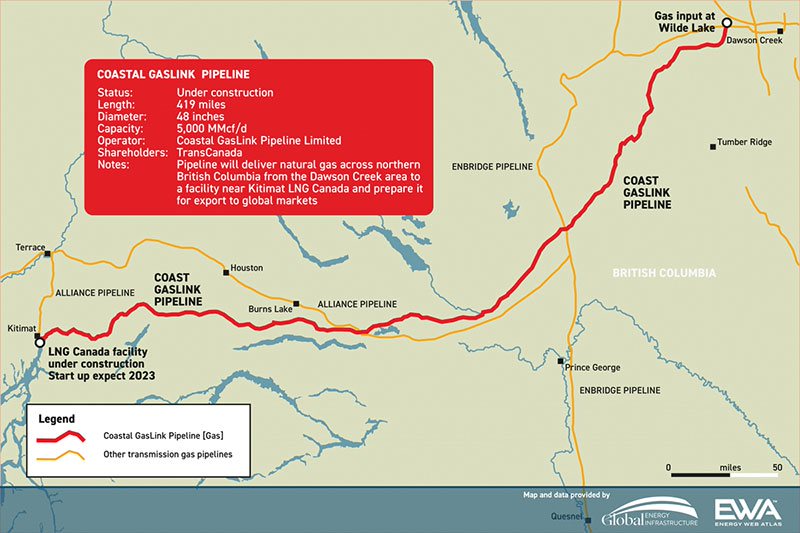February 2023, Vol. 250, No. 2
Editor's Notebook
Coastal GasLink’s Year of Milestones

By Michael Reed, Editor-in-Chief
(P&GJ) — As 2022 drew to a close, news came that one of the more complex pipelines projects ever seen in North America, the Coastal Gaslink project, had eclipsed the 80% completion mark in British Columbia.
The project, in combination with the Kitimat LNG plant, is the largest Canadian infrastructure investment since the 1950s when the St. Lawrence Seaway was constructed.
Arriving at this point has not been an easy task for pipeline-owner TC Energy and its partners. First announced in 2018, the 416-mile (670-km), faced several construction delays, a myriad of protests, including some by First Nations, the COVID-19 shutdown and even an attack on one of its camps by ax-wielding criminals.
RELATED: 416-Mile Coastal GasLink Pipeline Project Nears Completion
In March, TC Energy took a major step toward gaining better community relations for the Coastal Gasline by announcing an Indigenous buy-in program, with option agreements to sell a 10% equity interest in the pipeline to the communities within the project’s corridor.
“For years, we have watched industry and governments generate revenues from the operations of their projects, while we live with the impacts,” Justin Napoleon, chief of the Saulteau First Nations, said of the announcement. “This investment in Coastal GasLink will finally start to shift the landscape, aligning industry and Indigenous peoples’ interests.”
The option agreement is a further indications of a shift in both policy and public sentiment among companies working on Indigenous territories.
The complexity of the project, along with early delays, prompted TC Energy, in November, to say cost pressures had driven the expected price tag of the project to $11.2 billion, from earlier estimates of $6.6 billion.
Additionally, because of the pipe’s location, it was necessary to implement sophisticated erosion controls due to the potential for mudslides, as well as measures to account for drought – an unusual combination.
“Coastal GasLink is one of the most complex projects, certainly in my career, that I’ve never seen before,” said Bevin Wirzba, TC’s executive vice-president in charge of Canadian natural gas pipelines, during a November investor’s meeting in Toronto.
Complications aside, 2022 was a year filled of many milestones for the pipeline, which completed both the pipe installation in Sections 1 and 4, and that of the Wilde Lake compressor station. Additionally, crews began pipe installation at Cable Crane Hill, which completed 45% of its installation ahead of schedule.
Possibly more impressive was the fact that nine out of the 10 major water crossings along the route are now in place – no easy task considering the weather interruptions and the pipeline’s twisting course to the Shell-led (LNG) Canada installation on western coast.
The pipeline consists of eight construction sections, with four lead contractors in charge of two of these sections a piece. The lead contractors select various sub-contractors to advance the effort.
At the end of the year, a Coastal Gas update showed the pipeline had been completed in two of those sections – Section 1 from west of Dawson Creek to South of Chetwynd (Primary contractor: Surerus Murphy Joint Venture), and Section 4 from north of Prince George to northwest of Vanderhoof (Primary contractor: SA Energy Group).
Section 3, from east of McLeod Lake to north of Prince George, showed 83.2% of grading and 64.6% of pipeline installation was finished by the 1,164 workers based northeast of Bear Lake (Primary contractor: SA Energy Group).
Construction at Section 7 had 67.6% of grading and 32.4% of its pipeline installation completed (Primary contractor: O.J. Pipelines). Section 7 is located on the 48-mile (77-km) stretch from south of Houston to north of Morice Lake. That is the location where a camp was attacked in February 2022, and Wet’suwet’en First Nation hereditary chiefs and their supporters have engaged in blockades.
Other primary contractors on the project are Macro Spiecapag Joint Venture and AECON Group Inc. In all the five contractors will have been responsible for the hiring of more than 2,500 workers.






Comments